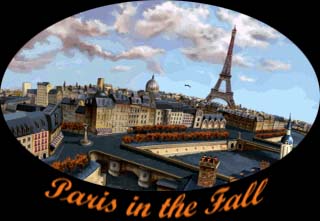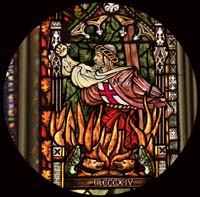
Circle of Blood
by





When George Stobbart decided to go on vacation in Paris, he was far from imagining that he would soon be on the point of discovering a terrible conspiracy. One that would bring him on a perilous adventure across Europe and the Middle East on a mysterious trail of the Knights Templar. It all started at the terrace of the "Cafe de la Chandelle Verte" in Paris where George stopped to drink a cup of coffee. At this time of the year, the streets of Paris had already been touched by the magic of Autumn, and the trees nearby the cafe had leaves colored of yellow and ocher tints. One could have stayed there for hours, listening to the birds, and watching the beautiful sight all around while enjoying the warmth of the autumnal sun. This peaceful atmosphere was however not going to last for long. As George was sipping his cup of coffee, a gentleman carrying a briefcase entered in the cafe, followed immediately by another man disguised in a clown costume, and playing an horrible tune on his accordion. The clown quickly reappeared a fraction of time later, running out of the cafe as fast as he could, his arms firmly holding the briefcase. Before George could even do anything, a violent explosion in the cafe projected him in the air.

When the game begins, George is slowly recovering from the blast, trying to understand what really happened to him. With the cafe's windows shattered all over the place, it was a miracle he wasn't wounded by the pieces of glass during the explosion. For George, there were no doubts about the clown's responsibilities in this abominable bomb attack that could have killed him, and it was clear now that he wouldn't rest until he sends this criminal to jail.
Like its two predecessors, Broken Sword features hand-painted graphics. The sketches, made in pencil, were first scanned, then colored on the computer. What makes the big difference between them, is that Broken Sword now uses the high resolution SVGA mode that delivers remarkably detailed graphics. The backgrounds for the numerous locations are absolutely stunning, of an exceptional beauty that largely contributes to the success of the game. From the dark sewers underground Paris to the arid mountains of Syria and the green hills of Ireland, each new location is a must see to be explored by the player. Additionally, animations such as other characters, flowing water, automobiles or leaves swept by the wind will add to the viewing pleasure and bring a dynamic component to the scenery. But far more impressive, is the scrolling of the screen. To introduce a cinematic depth in Broken Sword, up to ten parallel layers were created to build an entire scene. The advantage is that layers can move independently one from to the other when the screen is scrolling, giving a real perception of depth to the player. Broken Sword also contains 18 animated sequences showing some of your actions or scenes you will witness.
 |
| Jacques de Molay
burning at the stakes |
In Broken Sword, unlike other games, you don't have to try several different icons on various areas to find possible interactions. The pointer will automatically indicate if there is anything to do or to look at when you move it over the screen, by changing into the corresponding icon. This of course explains the right click functionality for the three icons mentioned at the end of the above paragraph. Without the right button option, there would be no possibilities of examining the object or character to interact with. Two other icons, a pointing hand and a beckoning hand, are also available in the game. The first one indicates a possible direction where you can go, while the second informs you that there is an another area off the screen. Moving George to the direction of the beckoning hand will scroll the screen and reveal another part of the location.
Playing a major role in adventure games, dialogues can rapidly become annoying when they become too long or when you must choose the right combination of answers among multiple choices to get through. Exploring all the possible paths of a dialogue tree has never been really exciting! To remedy this, the Broken Sword's interface will let you choose the subject you want to talk about with your interlocutor, and George will do the rest. Thus, subjects will be represented by small icons at the bottom of the screen, and clicking on one of them will have George initiate a conversation about it. When George has exhausted all his questions on a subject, the icon will disappear. Special icons will appear sometimes, such as a thumbs up meaning a positive answer, thumbs down for a definite no, angel for the truth and devil for a lie.
Placed at the top of the screen, the inventory will appear when you move the pointer there. If you click on a particular object, you can then move it on the screen until it becomes associated to the an icon. This doesn't necessarily mean that the combination will work (that would be too easy), and George will shrug his shoulders if it's not conclusive. For example, if you want to give an object to a character, just get the object from the inventory and place it over the person that will receive the object. You will then see the item associated to the mouth icon on the screen.
Besides the exceptional graphics, Broken Sword features one of the best soundtracks heard since the release of "The Dig" last year. Composed and conducted by Barrington Pheloung who did the music for "Truly, Madly, Deeply" and "Nostradamus", the soundtrack of Broken Sword is far from being the same repetitive tune that keeps playing over and over in your head even though you hadn't play for a few days. The over two hours of original music have various musical styles, influenced by the folklore of the countries visited during the game. What I really liked in the soundtrack was the way it was dynamically accompanying the game, lessening slowly during the dialogues, and going crescendo to highlight actions and events. Sometimes you could barely hear the music playing in the background, but then either the sound effects or voices would take the relay. Speaking of sound effects and voices, a great work has been done to make them realistic and convincing, such as spatial sounds (eg: the sound of a truck passing from left to right) and the numerous accents from over 60 characters.
Written by Frederick Claude
Click here for screen shots.
IBM-PC 486 DX2/66 Mhz or faster processor,
Min 8Mb memory,
Windows 95, or DOS 6.2 or higher,
Hard drive required with at least 18Mb free,
Double speed CD-ROM drive or faster,
256-color SVGA VLB or PCI video card VESA 2.0 compliant,
Microsoft compatible mouse.
Sound Blaster or 100% compatible.
Technical Support: Revolution
Software Technical Support
Web site: Revolution Software
Virgin Interactive Entertainment,
18061 Fitch Avenue,
Irvine, CA 92714.
| Technical Support: | 714-833-1999 |
| Fax Support: | 714-833-2011 |
| BBS Support: | 714-833-3305 |
Hints: 1-900-288-4744 ($.75 per minute)
Web site: Virgin Interactive Entertainment
In Europe:
In UK:
Virgin Interactive Entertainment (Europe) Ltd
2 Kensington Square
London W8 5RB
| Technical Support: | +44-(0)171-3682266 |
| Fax Support: | +44-(0)171-4682003 |
| BBS Support: | +44-(0)171-4682022 |
Internet Support: Virgin Interactive
Entertainment UK Technical Support
Web site: Virgin Interactive Entertainment
UK
In France:
Virgin Interactive Entertainment,
233 Rue de la Croix Nivert,
75015 Paris.
In Germany:
Virgin Interactive Entertainment GmbH,
Borselstrasse 16B,
22765 Hambourg.
In Spain:
Virgin Interactive Entertainment Espana,
Hermosilla 46,
28001 Madrid.
In Asia:
In Japan:
Virgin Interactive Entertainment Japan Inc.,
Nihonbashi Hisamatsu Building,
2-28-1 Hama-cho Nihonbashi,
Chuo-Ku, Tokyo 103.
In Pacific:
In Australia:
Virgin Interactive Entertainment Australia,
201 Miller Street,
North Sydney, NSW 2060.
| Graphics: | 95% |
| Sound: | 92% |
| Music: | 93% |
| Gameplay: | 90% |
| Interest: | 94% |
| Overall: | 93% |

 |
 |
| [Homepage] | [Back issues] |
All content Copyright © 1994, 1995, 1996 Coming Soon Magazine, Inc. All
Rights reserved.